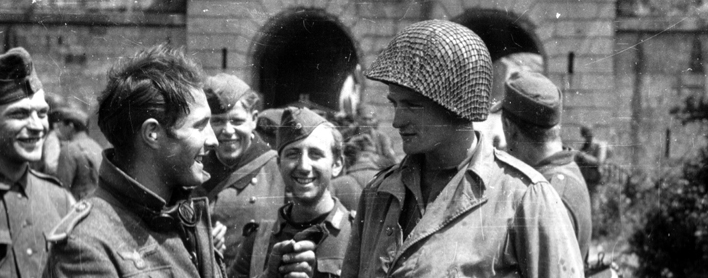
A tribute to the forgotten Victims and Veterans of WW2
WW2 was the most widespread war in history, and directly involved more than 100 million people from over 30 countries. At the end it resulted in an estimated 50 million to 85 million fatalities. These made World War II the deadliest conflict in human history.
Beeing a WW2 Military Vehicle collector is due to this fact a „heavy weight“ – we have allways to remember „the story behind“ our vehicles and have a kind of „special responsibility“ we should be aware of. Respect for the victims, the veterans and their relatives is part of that heritage as well as keeping up the memory of WW2 for generations to come – to prevent mankind from the deadly mistakes of our past.
Victims or offenders – can the question be answered after 70 years?
Among those millions of unknown victims are several members of my German part of the family: the brother of my grandfather and his son, both having been in the Wehrmacht as well as my great-grand parents. Others survived the war and kept on living after „zero hour“ as they did before the war. As my grandfather, that never talked about WW2 and his personal involvement on the „Heimatfront“. It is hard to decide today – after more than 70 years that have passed – if they have been victims or offenders, fanatic Nazis or just people „like you and I“ that wanted to survive in the times of Nazi dictatorship and WW2. As in many families in Germany nobody talked about this darkest hour in German history. All I know are some very few informations that I got from my father that passed away in 2012 and – born in 1942 – was to young to be a witness. So I tried to find out more details on my own and with the support of sources on the www, with visits of the original places, support of some archives in Germany and in the USA as well.
Find here the results of my research on the liberation of my hometown Frankfurt am Main (pdf file):
TIMETABLE OF THE LIBERATION OF THE CITY FRANKFURT AM MAIN
My photo-gallery on the liberation of Frankfurt can be found here: LIBERATION PHOTOS
The unknown WW2 Veterans
In addition I started to find out more about the American veterans „on the opposite side“ that owned or used 70 years ago some of the items that I have in my WW2 collection. Many of those items remain namless and are just anonymous mass-produced artefacts. Some – few – others have the names of the previous owner or a certain site where they have been found – so that there are some traces to the soldiers and their story behind. The results of the research on those nameless veterans that returned to the USA and tried to proceed with a „normal life“ after WW2 is described below as well – as „the other side of the medal“.
To put things right: from my point of view there is no argument to „glorify“ those victims – whatever side they belonged to. There is no „glory“ in being killed in a B-17 by a German 8,8 cm Flak grenade at 10,000 feet above the ground or in beeing vaporized by a 500 lbs bomb while sitting in a basement shelter for „the Fuehrer“ and his terror regime. And in contrast to the wartime propaganda we have to learn today that thing’s 70 years ago not have been „as simple as black and white“. That’s what I found out during my research on those traces of WW2 in the past years.
During WW2 about 17 million US Soldiers have been fighting on all frontlines. Today – 2015 – are about 1 million of them still alive. Each day are about 800 of them passing away. – And with them the witnesses of WW2. Each of them with his personal story on what happened in those days between 1939 and 1945 – and after. It’s up to us to preserve the heritage of those who liberated Europe from Nazi Dictatorship for generations to come. So this is a part of my motivation in those veterans profiles listed up below. It is hard to handle figures in large scale. But you can pick up some single persons to bring those day’s back and to keep the memory of them alive.
If you have a look at the picture above you have the „essential message“ at a glance: a group of captured Wehrmacht soldiers and a young US Soldier at about the same age. The Germans are truly glad that they are still alive and the war is over for them. You can directly see the heavy weight that has fallen off from them. The American is a bit sceptical and tries to figure out what is going on – if he can trust those guy’s that 24 h. before have been his enemy – and you can see that he tries to understand what is going on in this moment.
– I think he will have understood first lateron that those former enemies have been so euphoric because they had survived the Nazi regime and a war that was not their war.
– And that’s what we should keep in mind too and should teach our children – to prevent future generations from being part of a similar insanity again, that was finally leading into that what we know today as WW2.
The German side of the WW2 drama…
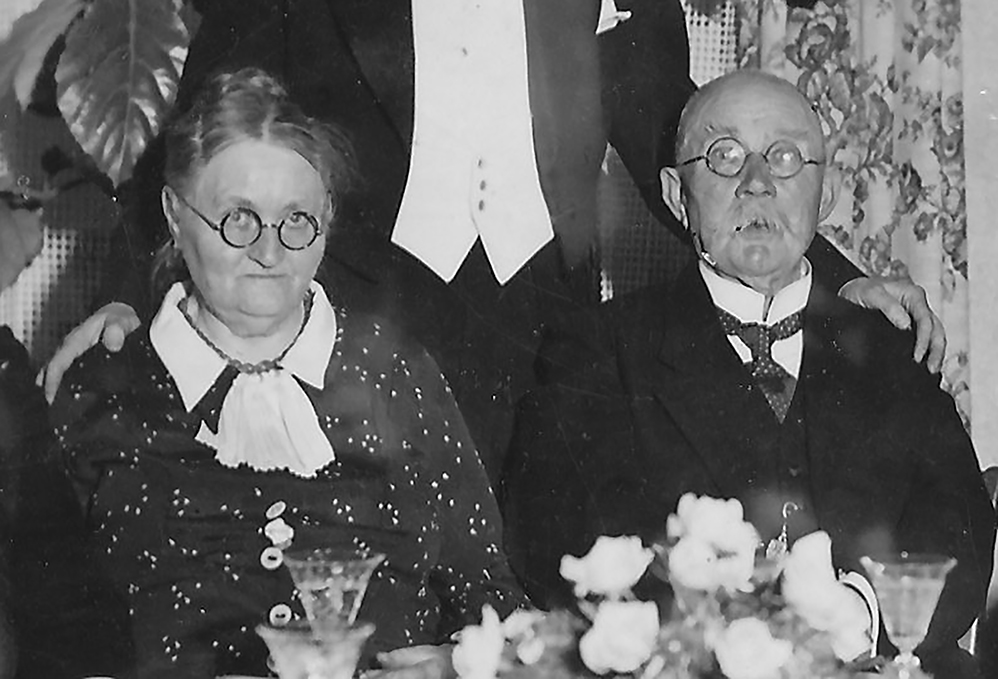
Marie and Hermann – victims of the war at air
My great-garndparents Marie and Hermann have been killed by a B-17 heavy Bomber raid of the 8th Air Force on the city of Leipzig on the 27th of Feb. 1945. All that remained of them was a small box with items that my grandfather found lateron between the piles of brickstones: the glasses of my great-grand father, his watch chain, some coins, a thimble and a small scissor of my great-grandmother. All blackened by the heat of the fire after the bombing.
The tragedy in that are the details of their death: as far as I know from my grandfather had my great-grand mother problems with her health and stayed in bed instead of going downstairs to the shelter. So my great-grand father came up from the shelter when the bomb hit the house. The office of my grandfather was only about 200 m. away and from his window he could see the bombs falling, that hit the housing area instead of the nearby railroad terminal. Both have been buried in a anonymous mass-grave at the Leipzig south cemetary – with about 700 other victims of the bombing on that day. So I added a stainless steel metal sheet with their names to our family graves backside. Just to give those „graveless“ members of my family „a place to be remembered together“ – 68 years after the end of WW2.
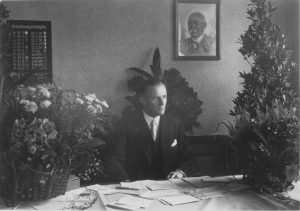
Walter – simply a patriot or „the typical Nazi“?
My grandfather Walter was a „classic patriot“: born in 1900 he joined the Emperors Army in 1917 as a volunteer with special permission of his parents as the youngest of three brothers. Living near the railroad tracks at Leipzig he could see the incoming sanitary waggon’s with the wounded from the frontline. In one of his books I found one day a sketch that he must have made from his window: It shows the railway station with the platforms and tracks filled to the very end with sanitary trains, partwise with the red cross on it. The amount of those trains on the sketch gives a slight impression of the dimension of WW1. My grandfather came then to the frontline in the west – but to late for active service in combat because the war ended before.
When he returned from the front to his hometown he started to study economyat the University of Leipzig and founded in 1921 his own steel trading company. The company was namend „Steinweden Stahl“ and he used the colours of the flag of the city of Leipzig – blue and yellow -as the colours for his Company logo.
As Germany’s youngest steel wholesaler, following completion of his studies he succeeded in developing the company on a continuous basis. – Despite of inflation and the global economic crisis from 1929 on. Through maintenance of good links to leading German manufacturers, one of the most wide-ranging steel warehouses in central Germany was created, specialising particularly in high-quality bright and tooling steels.
Thank’s to secret documents of the former GDR secret service (Stasi) I found then out in 2014 that my grandfather was a NSDAP member from 1932 on up to the end of „the Reich“ in May 1945. So there was the first time the evidence that rumors in the family had been right that stated that my grandfather was a Nazi.
But beside of his membership card of the NSDAP was in his Stasi file another interesting NSDAP document: it was an internal report about a NSDAP investigation on my grandfather and his „loyalty to the party“. The result of the investigation was then that „he was not political active“ for the NSDAP – a point that made him suspicious – but that all interrogated persons during the investigation only stated the best about him. So the investigation was stopped and the file closed without any accusation.
In addition he became a member of the chamber of commerce at Leipzig and was from 1936 on the second Vice President of the Chamber of Commerce. Because of this püosition and his ongoing steel trading business as a supplier for the wartime industry he was not pressed to duty in the military.
After the liberation of the city of Leipzig on April 18 1945 by the 69th Infantry Division my grandfather was arrested for some weeks by the Americans and then lateron by the Sowjet administration. After his release from the Sowjet prison he succeeded in making a new start at the „zero hour“, initially on a small scale in a totally destroyed city. In 1946 he was running his business again and could celebrate the 25th anniversary of his steel trading company with a small group of employees – only about a ¼ of his staff that he had before WW2.
But only a short time later, in 1952, he had to flee to the west, shortly before the company was to be nationalised by the SED regime of the new founded GDR. At the age of 52 he faced the challenge of building up the company again in Frankfurt am Main in Western Germany. In this well-known city, where many trade fairs also take place, the Walter Steinweden steel wholesale company expanded again and achieved a leading position amongst suppliers of high-quality bright, tool and stainless steels.
When my grandfather had passed away in 1990 at the age of 90 I found an old Marlene Dietrich single record from 1962 at his home. The title was „Where have all the flowers gone“ – one of the most impressive anti war songs ever performed (lateron from Joan Baez too), but today nearly forgotten as most of the victims of WW2. So the question that „popped up in my mind“ was: if my grandfather was really a Nazi, how can it be that this song was among his records? And „even worse“: the song was in the version of Marlene Dietrich, the so called „Vaterlandsverraeterin“ which fought on the side of the Allied troops against her own country.
During my research on the life of my grandfather I found beside of this single record a lot of his older private books. Partwise from the 1920ies, 30ies and 40ies. While having a closer look at those books I found in some of them dedications, hand written with ink pens. Among them some of members of his students union. This would not have been interesting as such – more interesting was to see the dates: some of them after 1936 – when the Nazi’s banned all students unions and meetings of their members. So this was an evidence, that my grandfather was supporting his union still after that and kept on meeting members – braking clearly the law of the Nazi regime.
So I would not say that my grandfather was free of any sort of guilt or that he was working in the underground directly against the Nazi regime. But after finding small details like this it become more evident that he just was a party member to keep his business still running under the years of the Nazi dictatorship.
It is hard to say if he was supporting the Nazi ideology or if he was one of the many patriots that have been dazzled by the Nazi ideology in the beginning of the 1930ies. But I know from a statement of him when I was a child that he was having a speech in public in 1938 against the visible danger of an upcoming war and was warned to leave before the Gestapo would show up at the Event. So this statement is giving an evidence that well informed persons did see the danger of an upcoming war at that time – and that he was not supporting this way that was leading finally to WW2.
To sum up my research on my grandfather and the „question of guilt“: it seems to me that thing’s never have been simply „black and white“ – and that the answers to my questions never have been as simple as this.
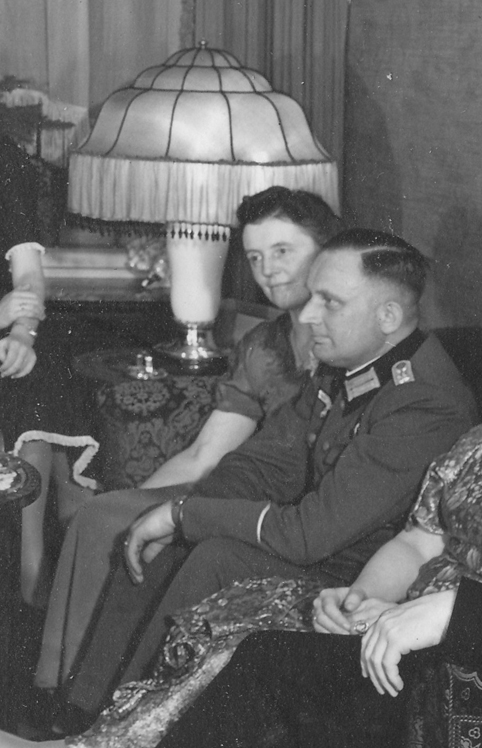
Hans the Wehrmacht Officer – a war criminal?
Hans – the older brother of my grandfather Walter – was in the Army in WW1 and has been decorated with the iron cross. At the beginning of WW2 he was to old for the active service at the front. So he was ordered to do his service as a officer of the reserve at the „homefront“ and not far from his hometown Leipzig. In my family nobody had any informations about what happened to him in the last days of the war and he was reported to be missing in action.
In fact he was on duty at the administration of a POW camp (STALAG) at the city of Bautzen. I could not find any further details about him and his function at this camp or about the camp itself up to now. So it’s hard to say if he was involved in any POW deaths or „thing’s of that kind“. Knowing the background of the family and the fact, that his son was in opposition to the Nazi regime – paying lateron with his life for that – I would say that he was only „another small wheel“ as so many in the Nazi machinery that did his job as he was told and „kept thing’s going“ – up to the bitter end… However – I was quite astonished when I found his name in the death records of a Soviet „Special“ Prison Camp at Bautzen in 2011.
– It was the first evidence of what had happened to him for my family since 1945. So he must have been in this special prison Camp no. 4 from 1945 on to March 1948 without contact to his family and must have died there – three years after his son Hans-Joachim. There is no evidence given, if he has been executed or simply died of the hunger and cold in that Soviet „special Camp“.
Background: The Soviets had installed more than 70 of those NKVD „special camps“ and sent active Nazis into those „installations“ as well as political opponents of all types as democrats, socialists and all sorts of other „suspects“ – if guilty or not. Even teenagers have been reported to be sent into those camps. Trials with three NKVD and Soviet Army officers decided in those camps on „life or death“ of the prisoners. Death was all around, every day and this was terror of another kind – not better than the terror of the Nazi-Gestapo before. The last of those (mostly kept secret) special prisons have been closed in about 1950 and there is no evidence given, how many people have been killed in those installations until then. Estimations are that about 123,000 Germans and 35,000 citizens of other nations were detained, at least 43,000 of whom did not survive – or even more.
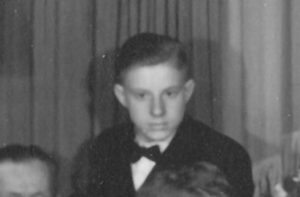
Hans-Joachim – refusing Nazi orders and KIA in a „Strafbatallion“
My fathers cousin Hans-Joachim was not willed to join the Wehrmacht – but was forced to. Because of his unwillingness to serve the Nazi terror regime in a war that could not be won anymore he was soon in trouble. I have only some brief data of his Wehmacht file that I found at the archive in Berlin – but they are indicating that he was sentenced to duty in a „Bewährungsbatallion (a.k.a.: Strafbattalion). This was as beeing sentenced to death, because soldiers that ended up in those units had in fact never a chance to return to the regular troops or to return alive from the frontline. Hans-Joachim was pressed to duty in the Bewährungsbatallion 501 and killed in action in Poland on the 18.09.1944 at the age of 18.
Some years ago his body has been recovered with other soldiers from the original grave site and been transferred to a new WW2 cemetary at Pulawy (Poland), near the city of Lublin. Since the cemetary has opened in the year 2000 have been 20.981 soldiers been transferred to this site.
So – from my point of view – is Hans-Joachim the answer to the classic question „why did nobody refuse to support the Nazi regime?“.
In fact there have been many since the Nazi takeover in 1933, but most paid their civil disobedience with their life, ending in a Gestapo jail or a concentration camp. Many of those „silent heroes“ are nameless still today – and will ever be.
The Wehrmacht was thinking „more practical“ and sended the convicted soldiers to the frontline as „cannon fodder“.
– A one way ticket to hell: Up to 27.000 Wehrmacht soldiers have been pressed in to service in such Batallions. Most of them did not survive WW2.
Latest update: 16.10.2018